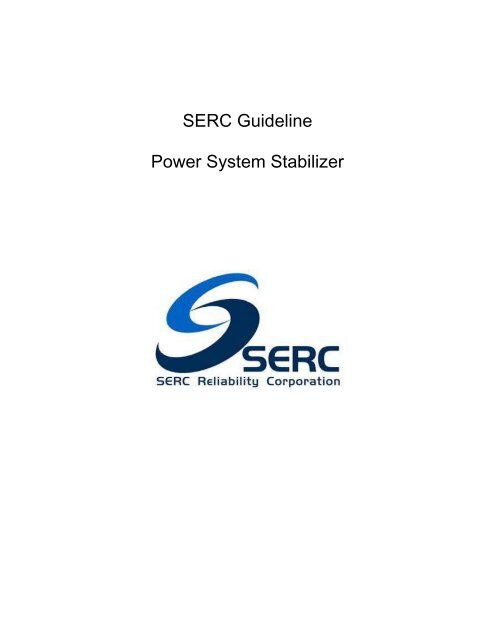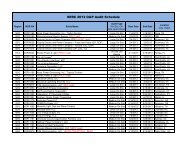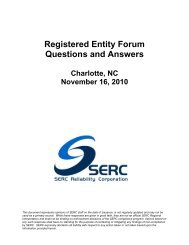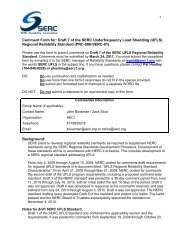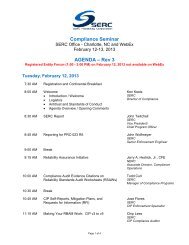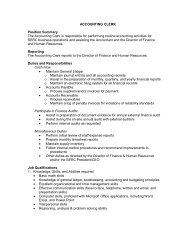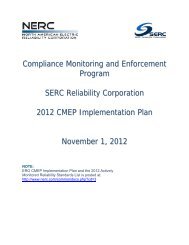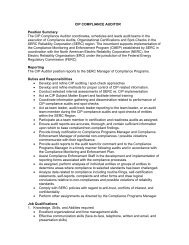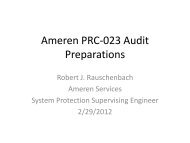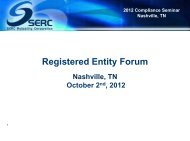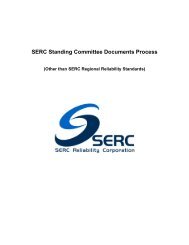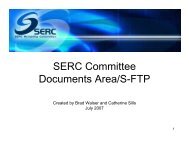Power System Stabilizer Guideline - SERC
Power System Stabilizer Guideline - SERC
Power System Stabilizer Guideline - SERC
You also want an ePaper? Increase the reach of your titles
YUMPU automatically turns print PDFs into web optimized ePapers that Google loves.
<strong>SERC</strong> <strong>Guideline</strong><br />
<strong>Power</strong> <strong>System</strong> <strong>Stabilizer</strong>
<strong>SERC</strong> <strong>Power</strong> <strong>System</strong> <strong>Stabilizer</strong> <strong>Guideline</strong><br />
Revision History<br />
Revision Date Comments<br />
0 05/25/05 Initial approval of document.<br />
1 08/08/08 Incorporated some minor updates and to<br />
establish it as a separate document from<br />
the FCR Supplement<br />
2 10/06/11 Made minor editorial revisions<br />
Responsible <strong>SERC</strong> Sub-group & Region Review Group<br />
The <strong>SERC</strong> EC Dynamic Review Subcommittee (DRS) is the Responsible <strong>SERC</strong> Sub-group<br />
(RSS) for this guideline.<br />
Review and Recertification Requirements<br />
This guideline will be reviewed every three years or as appropriate by the DRS for possible<br />
revision. The existing or revised document will be re-certified and distributed to all members by<br />
the <strong>SERC</strong> Engineering Committee.<br />
<strong>SERC</strong> EC Approved on October 6, 2011 Rev 2<br />
i
<strong>SERC</strong> <strong>Power</strong> <strong>System</strong> <strong>Stabilizer</strong> <strong>Guideline</strong><br />
<strong>SERC</strong> <strong>Power</strong> <strong>System</strong> <strong>Stabilizer</strong> <strong>Guideline</strong><br />
<strong>Power</strong> oscillations on the transmission grid are becoming a problem for the transmission<br />
system in the <strong>SERC</strong> Region. A <strong>Power</strong> <strong>System</strong> <strong>Stabilizer</strong> (PSS) is an electronic feedback control<br />
that is a part of the excitation system for generating units. The PSS acts to modulate the<br />
generator field voltage to dampen power system oscillations. FERC Order 2003 states that<br />
“The Interconnection Customer shall procure, install, maintain and operate <strong>Power</strong> <strong>System</strong><br />
<strong>Stabilizer</strong>s in accordance with the guidelines and procedures established by the Applicable<br />
Reliability Council. Transmission Provider reserves the right to reasonably establish minimum<br />
acceptable settings for any installed <strong>Power</strong> <strong>System</strong> <strong>Stabilizer</strong>s, subject to the design and<br />
operating limitations of the Large Generating Facility. If the Large Generating Facility’s <strong>Power</strong><br />
<strong>System</strong> <strong>Stabilizer</strong>s are removed from service or not capable of automatic operation, the<br />
Interconnection Customer shall immediately notify the Transmission Provider’s system provider,<br />
or its designated representative.”<br />
Historically, transmission systems have needed stabilizers at only a few special locations.<br />
However, as transmission systems become increasingly loaded and generators are added, the<br />
stability margins of the transmission system become more critical. Stability studies have shown<br />
that while the first new generator added in an area may not cause a power oscillation problem,<br />
the subsequent addition of generation in the area may result in oscillatory conditions requiring<br />
the new and/or existing generation in the area to have stabilizers.<br />
It is easier and less expensive to activate a PSS at the time the generator is put into service<br />
than to add it at a later date. In order to insure the integrity and reliability of the transmission<br />
system, <strong>SERC</strong> recommends that a PSS be procured, installed, tuned, and activated on all new<br />
resources interconnecting with the transmission system.<br />
If generators that were in service before the effective date of this guideline receives excitation<br />
system or voltage regulator replacements, then a stabilizer is recommended to be procured and<br />
installed. If the Transmission Planner determines the need, or if the generator already had an<br />
in-service stabilizer before the excitation system or voltage regulator replacement, these<br />
retrofitted stabilizers should be tuned and activated. Following the effective date of this<br />
guideline, if the need for a stabilizer is identified by the Transmission Planner for an existing<br />
unit, the Transmission Planner may require the Generator Owner to procure, install, tune and<br />
activate a stabilizer.<br />
The Generation Owner is responsible for the procurement, tuning and testing of the exciter and<br />
stabilizer controls for optimum performance and for providing a stabilizer model and data<br />
consistent with the requirements of the individual Transmission Planner.<br />
The stabilizer is expected to be an accelerating power delta-P-omega (ΔPω) type. Other types<br />
that are functionally equivalent to the delta-P-omega type may be accepted on a case-by-case<br />
basis. Special studies and field tests are required to tune a PSS and to establish its settings.<br />
These studies and field tests will be the responsibility of the Generator Owner prior to<br />
commercial operation. It is anticipated that most of the time, the generator equipment vendor<br />
can be retained to perform the studies and tests. The Transmission Planner should perform<br />
other relevant studies and should coordinate with the Generation Owner and the equipment<br />
vendor (or consultant) to establish reliable settings for the PSS. <strong>SERC</strong> recommends that for<br />
new generators the PSS tuning test documentation as specified in the <strong>SERC</strong> Regional Criteria<br />
<strong>SERC</strong> EC Approved on October 6, 2011 Rev 2<br />
Page 1
<strong>SERC</strong> <strong>Power</strong> <strong>System</strong> <strong>Stabilizer</strong> <strong>Guideline</strong><br />
<strong>System</strong> Modeling Data Requirements be provided prior to commercial operation. For the retrofit<br />
of a PSS to an existing unit, the documentation should be provided when the testing of the PSS<br />
is complete. If future system conditions change significantly, the Transmission Planner may<br />
request the Generator Owner to reset the PSS parameters to more appropriate settings to<br />
preserve the overall reliability of the grid.<br />
The Transmission Planner may provide criteria to allow the power system stabilizer to be taken<br />
out of service. The PSS should be taken out of service for scheduled maintenance only<br />
following consultation between the Generator Owner and the Transmission Operator and with<br />
the agreement of the Transmission Operator. The Generator Owner should be requested to<br />
take the PSS out of service if the Transmission Operator identifies transmission system<br />
operating conditions during which the operation of the PSS adversely affects the stability of the<br />
transmission system or its connected generators. If a power system stabilizer is removed from<br />
service or is not capable of automatic operation, the Generator Owner should immediately notify<br />
the Transmission Operator. Operating limits may apply in such cases based on system needs<br />
identified by the Transmission Operator.<br />
Unless the Transmission Planner determines that system studies or operating experience<br />
show need for a PSS, then generators rated less than or equal to 50 MVA or generators<br />
connected at a nominal system voltage level below 100 kV are not expected to install a new<br />
PSS. This only applies to plants where the total generation does not exceed 300 MVA.<br />
The guideline is effective upon approval by the <strong>SERC</strong> Engineering Committee.<br />
<strong>SERC</strong> EC Approved on October 6, 2011 Rev 2<br />
Page 2


